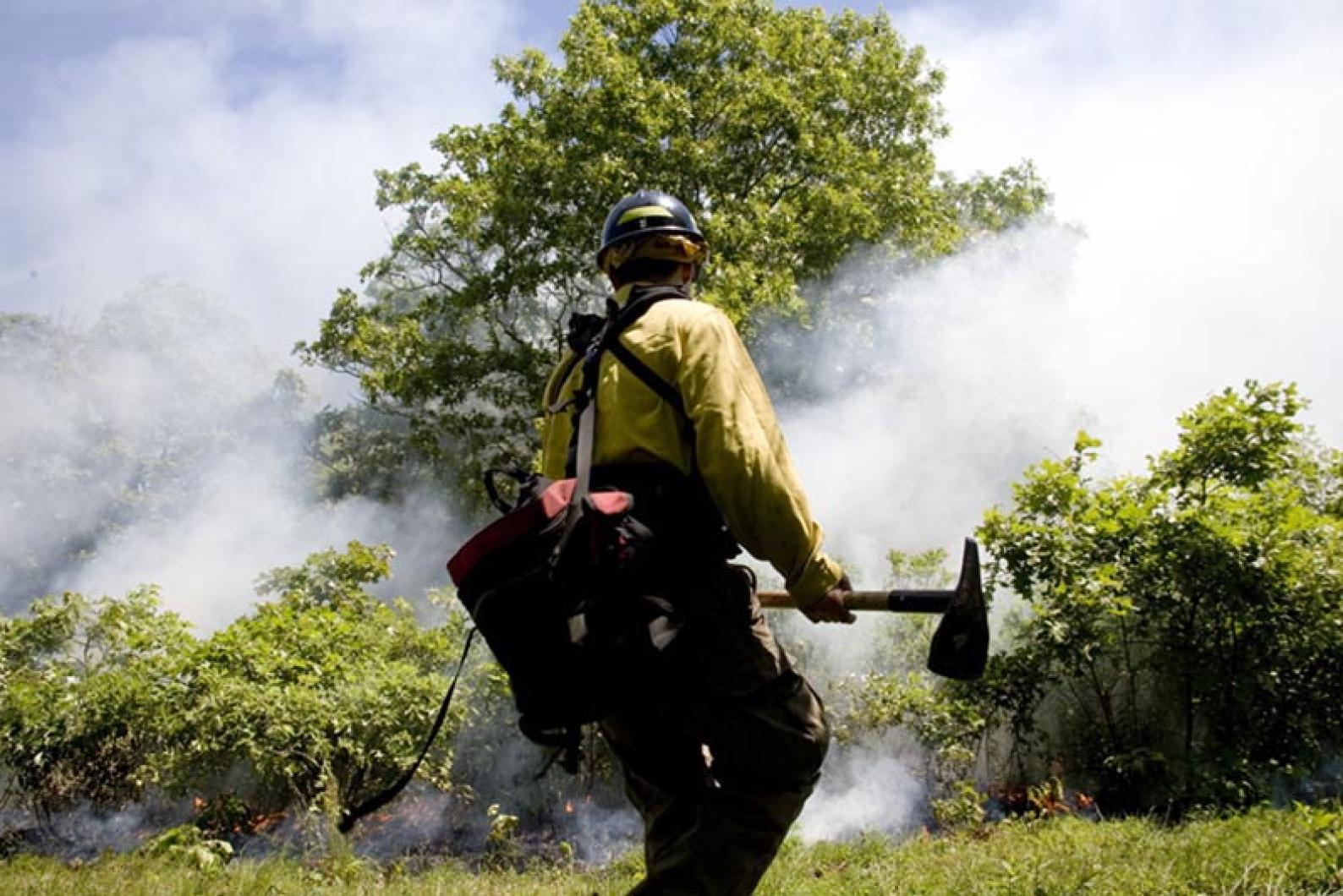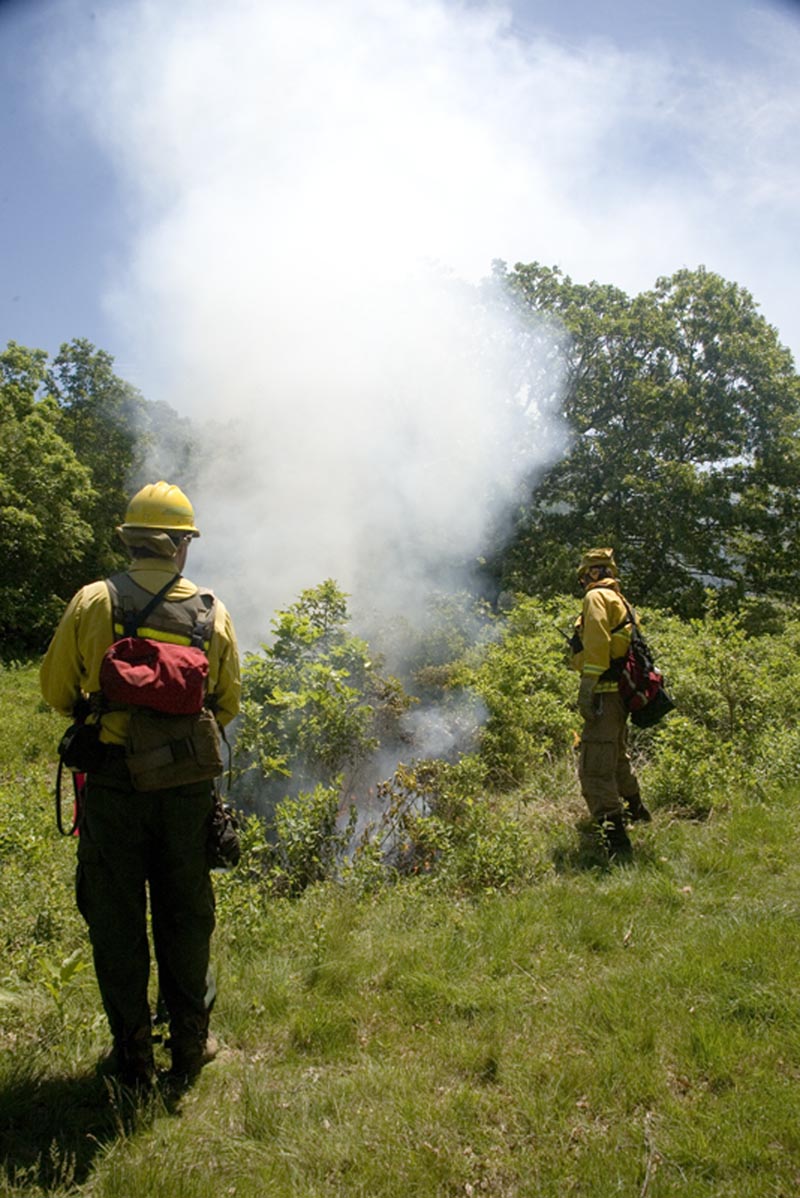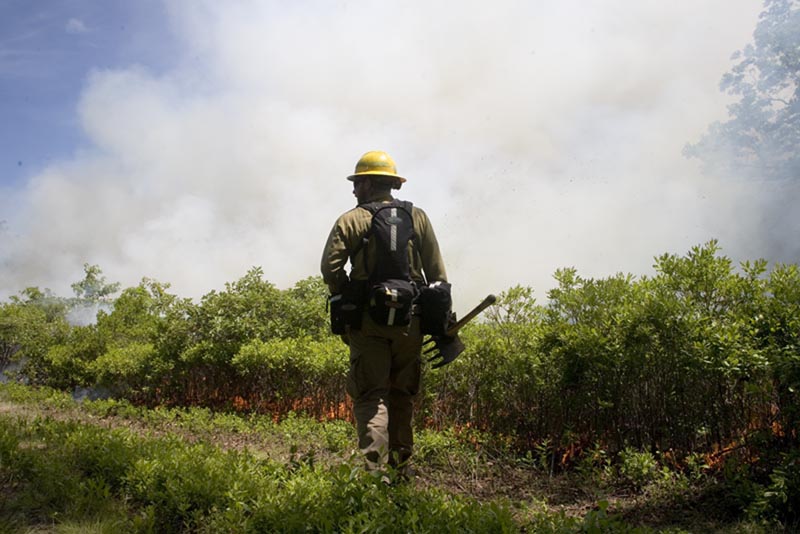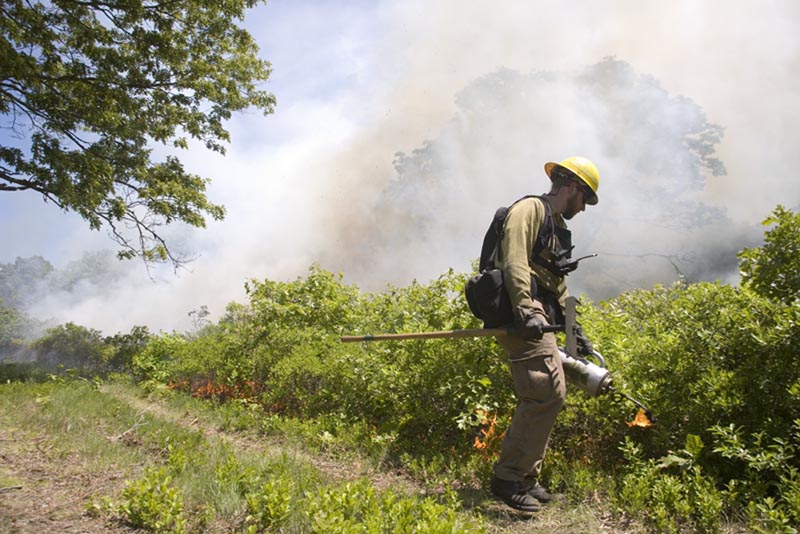The back of the T-shirt read: “Burn Crew 2007. Burning landscapes near you.” Under those words was the equivalent of a band’s performance schedule, a dozen locales across six states.
And even though the wearer of the shirt and eight other members of her group were sitting around in a circle in a weedy clearing in the woods in firefighting gear on Wednesday, it was very like the atmosphere at the sound check before a music gig.
Getting everything set right, before the excitement. There literally is a sound check, as all nine members of the crew check their radios. And there’s a lot more than that to getting ready. To start a fire these days, you don’t just light a match, you know.
Not, in particular, if your goal is to preserve what you burn.
What they were about to burn is 20 acres of conservation land in West Tisbury at the Edwin Newhall Woods preserve. The goal is for the flames to consume 50 to 80 per cent of the accumulated litter on the ground, and to kill about 50 per cent of the woody understory of the area, to open it up to a greater diversity of plants.
Those are quite precise goals and require quite precise control.
So Bob Bale, The Nature Conservancy’s Massachusetts chapter fire and restoration manager, was running through the parameters of the fire before they actually lit anything.
Temperature 78 degrees Fahrenheit, wind from the north-northwest at three miles per hour with gusts to five. Relative humidity readings varied widely — 46 to 63 — but they were okay and would fall further as the day progressed.
“The Haines index is at four, [there are] high mixing heights, clear sky, so I expect the smoke to lift,” Mr. Bale said.
Under the circumstances, he estimated, flame heights would be about three feet or six feet-plus if a head fire started in the scrub. The fire would move at about 15 feet per minute.
Everything looked good.
The group’s fire ecologist Lucy Brudnak, ex-U.S. forest service, had already scattered instruments to measure the heat of the fire for later analytical purposes.
“Her former boss at the forest service this year just happened not to be using his thermocouple dataloggers,” said Mr. Bale.
Then it was a matter of wetting down adjacent areas which were not meant to burn, and setting the fire, with a combination of diesel fuel and gasoline dripped from a pot.
It was all pretty routine for these folks. Their eighth controlled burn on Martha’s Vineyard this spring, following another five before that in New Hampshire. Members of this group have lit or fought fires across much of the country.
“The Nature Conservancy burns in, I think it’s 38 states now. We burn roughly 100,000 acres just of TNC land every year. And far more than that on partner agency — county, state federal — land,” said Mr. Bale.
The fire crew members tend to move around a lot, just like the T-shirt says.
“There’s movement between crews for experience in different fires,” Mr. Bale said.
On this crew, he says a couple formerly worked in the Midwest. One is a “hot shot from out west.” Another formerly worked in “a full time suppression job with a federal agency,” until he got more interested in using fire than in just putting it out.
And in fact large parts of this country, including this Island, used to burn quite regularly.
“We know there was a very high incidence of fire on the Island,” said the Islands program director for the conservancy Matt Pelikan “Fire was a major shaping force on the Vineyard for many centuries.”
Then for a long time, fire was suppressed and the landscape changed. Fire-adapted plants lost their relative advantage. Controlled burns are an attempt to protect and restore the old landscapes.
In this case, as said, that meant preserving a relatively small area of sandplain grassland.
“This area is a little pocket of sandplain soil that runs up the Mill Brook valley and into the Woods property. It has been kept open for many decades, by grazing, then mowing.
“And now, by burning.
“We know that there was historically a very high incidence of fire on the sandplain and a much lower one on the oak woodland of the moraine. Here we are burning the interface between that sandplain and the oak woodland that surrounds it,” Mr. Pelikan said.
And how did it go?
Entirely according to plan, said Mr. Bale afterwards. Both the subunits, as he called the two areas of land — about 20 acres in total — burned well. By which he meant unevenly.
That is, in some areas the fire was thorough, which means very hot, burning everything. Elsewhere it killed vegetation but left it standing; other places were barely affected. That’s good, in the jargon term mosaic burning.
Now, of course, it becomes a matter of crunching the numbers from the thermocouples and monitoring what plants spring up, which might take years.








Comments
Comment policy »